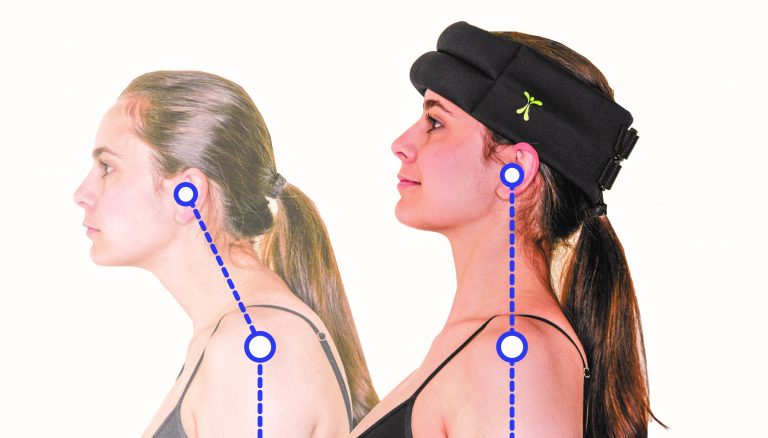Getting Started with the Active Traction Unit (ATU)

Before getting started with the Active Traction Unit (ATU):
When beginning this or any other fitness program, you should consult your physician or other health care professional to determine if it is right for your particular needs. In order for a person to qualify for active rehabilitation with the Active Traction Unit (ATU), they MUST NOT BE IN PAIN PAIN WHILE PERFORMING ACTIVE TRACTION.
Ideally, they should have some pain-free range of motion in the neck, (in all directions), BEFORE starting with ATU training protocols.
It goes without saying that the ATU is contraindicated with people suffering from ACUTE disc problems, ACUTE sprain/strain injuries and anyone else whose symptoms increase whilst performing the ATU protocol.
Active Traction Unit (ATU):
The Active Traction Unit comes in 3 sizes which range in weight from 1 pound to 3 pounds. There are a number of factors that will help ensure you use the proper size.
Physical fitness, age, sex, frame size, strength, degree of dysfunction, the presence of symptoms (PAIN), fitness level, balance and coordination must all be taken into account when making your decision about what size ATU to use.
That being said, below you find a general guideline:

REMEMBER, this chart is only a guideline. Some people, due to a high level of fitness can handle more weight and for others, especially those dealing with chronic pain, it’s better to begin with a lighter weight. The take away here is that the poorer a person’s physical condition, the longer the process of posture correction will take.
When in doubt, USE LESS WEIGHT and/or TIME. You can always add more weight later, but when starting off – you should come away from a session of Active Traction feeling like it was easy.
Things to watch out for:
- The weighted portion of the device MUST be positioned FORWARD and should rest slightly above the eye brows.
- The nylon adjustable straps should be positioned toward the rear and adjusted to COMFORTABLY FIT the circumference of your head. The weight should not press into the head. It should REST EASILY on the head.
- Be sure the weighted portion IS CENTERED in the middle of the forehead. Use your fingers to feel for the tapered ends of the weight and a mirror to ENSURE PROPER CENTERING.
- Make sure that you push the Active Traction Unit UP – and that it DOESN’T PUSH YOU DOWN. You want to imagine a dot on the crown of your head that you are trying to push upward to the sky. Strive to make yourself as tall as possible while using the ATU.
- Watch out for and immediately correct any excessive backward bending of the lower back or pushing forward of the hips. This is generally caused by atrophy and weakening of your body’s antigravity muscles (as is commonly seen with Posture Prolapse Syndrome). You must strive to maintain a neutral pelvis at all times while performing Active Traction.
- IMPORTANT – DO NOT increase your training time with the ATU until you can consistently maintain proper position for 1-2 minutes.

Active Traction Timing:
The issue of timing is much more straight-forward than sizing. Training with the Active Traction Unit MUST happen with enough REGLARITY to force a physical adaptation while, at the same time, avoiding any over training that could lead to excessive wear and tear.
- Almost all people will begin at 1-2 minutes per day, 6-7 days per week.
- Keep the time CONSTANT for the first week or two (1-2 minutes per day)
- After the first 1-2 weeks, a person should aim to increase the time by one to two minutes per week. (This should be broken down to roughly a 10 second increase each day). Some people can handle greater increases in time and for others, going slower is better – Remember to listen to your body.
- The long-term time goal is 20 minutes per day, seven times per week (until forward head posture has been eliminated at which point the patient can shift to a maintenance schedule).
It’s imperative to keep any soreness to an absolute minimum or, better yet, avoid it all together. If you feel fatigued, cut the time that day – and try again the next day.
Active Traction Implementation:
The Active Traction Unit (ATU) protocol MUST ALWAYS be performed with bare feet. Not only will bare foot contact with ground increase Kinetic Flow but, elevated heels work against you by pushing your head further into forward head posture. Any shoes with elevated heels MUST be avoided.
To achieve THE BEST POSSIBLE RESULTS, Active Traction should be preceded by mobility work (of the spine), stretching of any mechanically advantaged muscles (that are contributing to the functional/postural problem), and targeted strengthening of muscles responsible for pulling your body into extension (away from fetal position). Refer to the Pain Fix Protocol – Solutions Series for specific recommendations.
The purpose of doing these other things BEFORE Active Traction is to DRIVE UP Kinetic Flow and prepare your body for the powerful training stimulus provided by the ATU.
It’s best to start off your Active Traction Training by standing in place. As comfort level, body awareness, balance, strength and physical fitness increases, you can slowly progress up the Kinetic Flow continuum. And onto performing more complex tasks while wearing the ATU. These other positions and movements drive increased Kinetic Flow to the brain and may be added PROVIDED you FEEL COMFORTABLE and can maintain PROPER POSTIONING AT ALL TIMES.
The Kinetic Flow Continuum:
- Standing
- Standing on one foot
- Standing on a wobble board or inflatable balance disc
- Walking
- Walking backward
General Tips:
- If you EVER experience soreness 12-24 hours after a session of Active Traction, simply cut the last time you used by 50%. It’s important to GO SLOW with Active Traction Training – GIVE YOUR BODY CONSISTENT INPUT (by wearing the deivce daily) and THE TIME IT NEEDS TO ADAPT.
- Performing Active Traction IN FRONT OF A MIRROR can be a hugely beneficial tool for learning proper positioning (for the head/neck and the ATU) as well as for developing general body awareness. This is strongly recommended for the first 2 weeks of wearing the device.
- REMEMBER the key to the Active Traction Training System and the Pain Fix Protocol program is CONSISTENCY OVER TIME. You are working against the unrelenting force of gravity and its’ unrelenting effect your physical being. Each minute spent using the Active Traction Unit is building up your body’s resistance mechanisms and moving you towards optimal performance.
GENERAL DISCLAIMER
Exercise and health are matters that vary from person to person. Viewers of these programs should speak with their own doctors about their individual needs before starting any exercise program. This Web site is not intended as a substitute for the medical advice and supervision of your personal physician. Any application of the recommendations set forth in the following pages is at the viewer’s discretion and sole risk. If you are over 30 years of age or have been inactive for a few years, see your physician before beginning any fitness program. The Pain Fix Protocol and WCC do not warrant that the information on the painfixprotocol.com website or in email communications.
You should consult your physician or other health care professional before starting this or any other fitness program to determine if it is right for your needs. This is particularly true if you (or your family) have a history of high blood pressure or heart disease, or if you have ever experienced chest pain when exercising or have experienced chest pain in the past month when not engaged in physical activity, smoke, have high cholesterol, are obese, or have a bone or joint problem that could be made worse by a change in physical activity. If you have any doubts whatsoever, consult your physician. Do not start this fitness program if your physician or health care provider advises against it. If you experience faintness, dizziness, pain or shortness of breath at any time while exercising you should stop immediately.
This site offers health, fitness and nutritional information and is designed for educational purposes only. You should not rely on this information as a substitute for, nor does it replace, professional medical advice, diagnosis, or treatment. If you have any concerns or questions about your health, you should always consult with a physician or other health-care professional. Do not disregard, avoid or delay obtaining medical or health related advice from your health-care professional because of something you may have read on this site. The use of any information provided on this site is solely at your own risk.
Developments in medical research may impact the health, fitness and nutritional advice that appears here. No assurance can be given that the advice contained in this site will always include the most recent findings or developments with respect to the particular material.
If you are in the United States and think you are having a medical or health emergency, call your health care professional, or 911, immediately.
